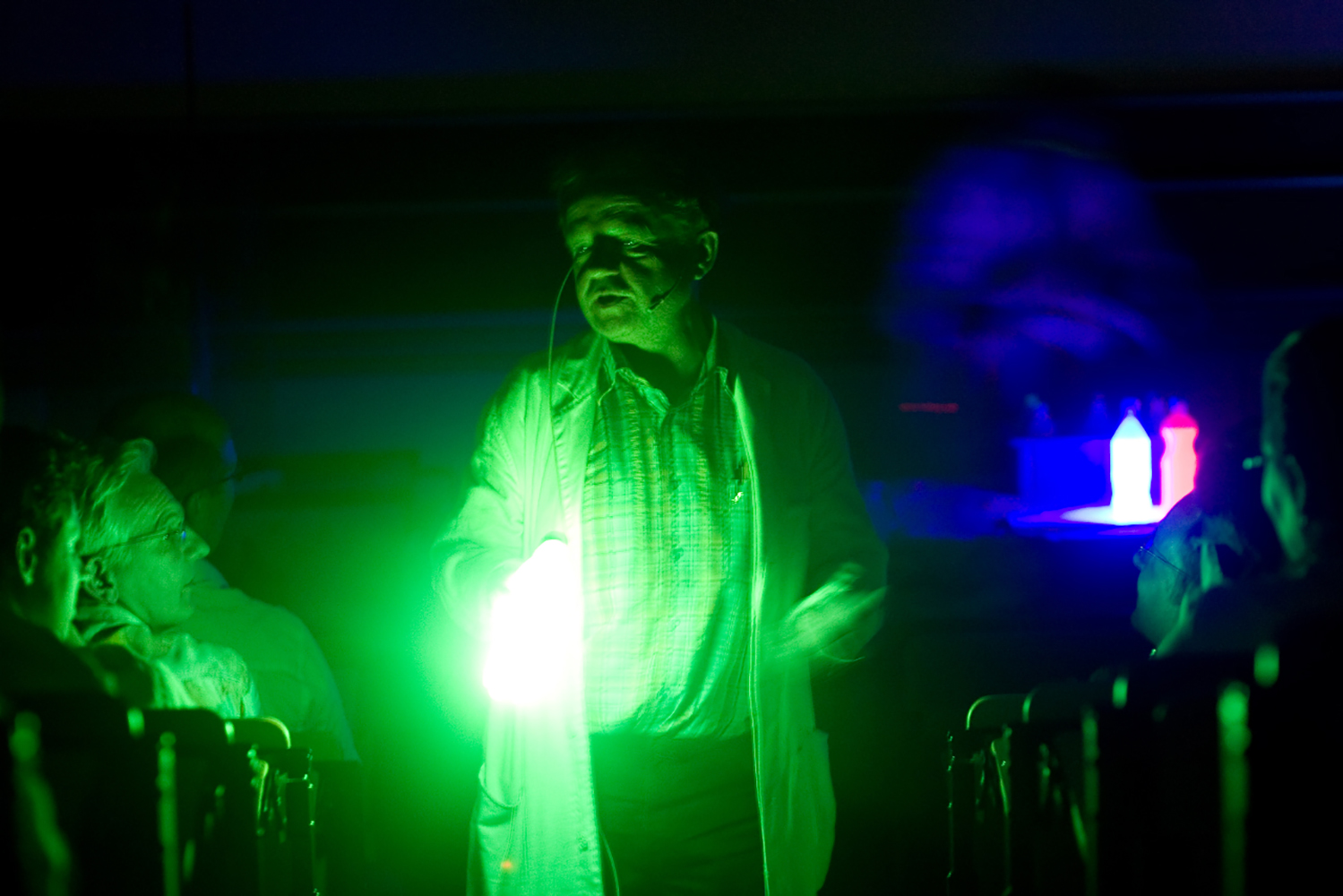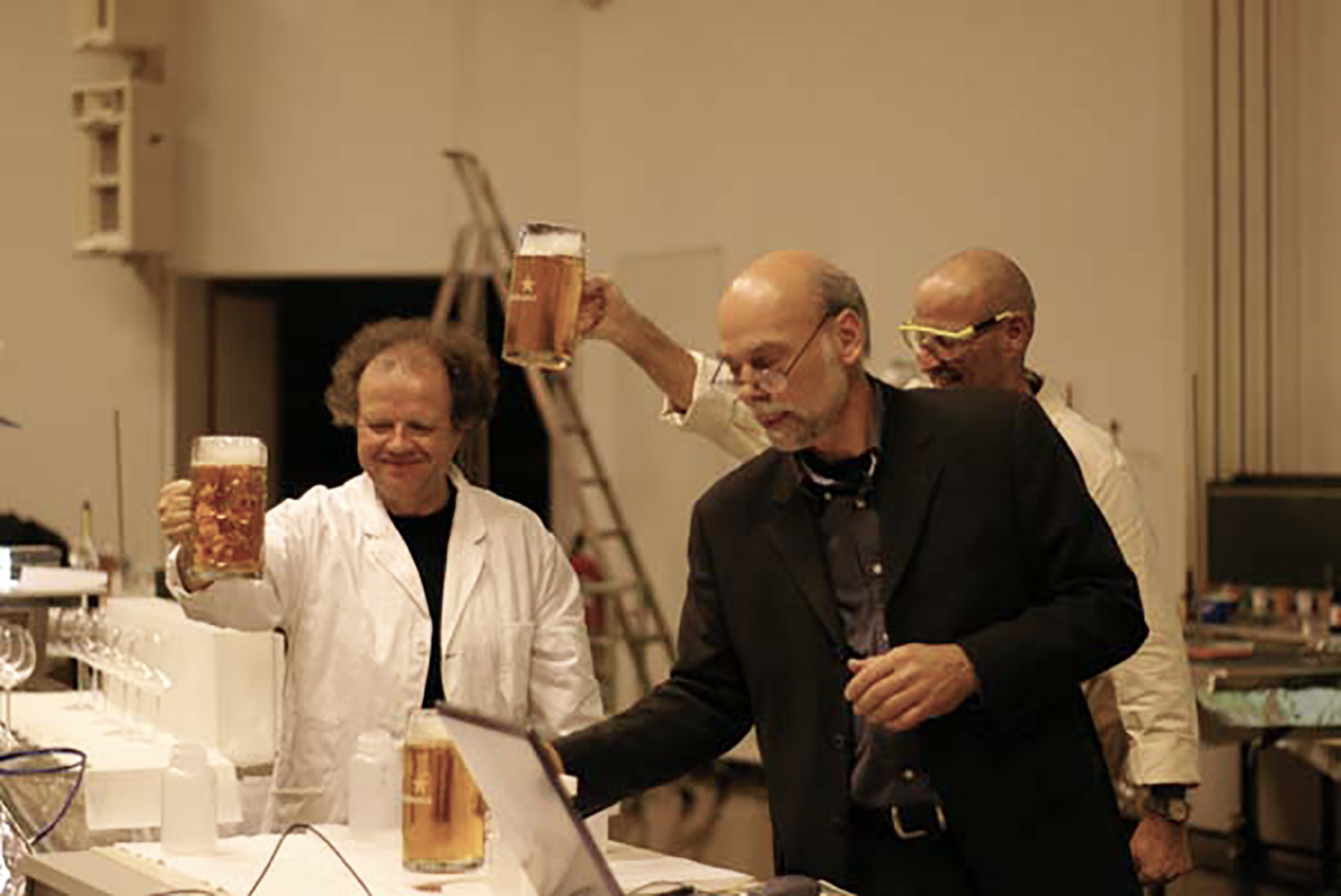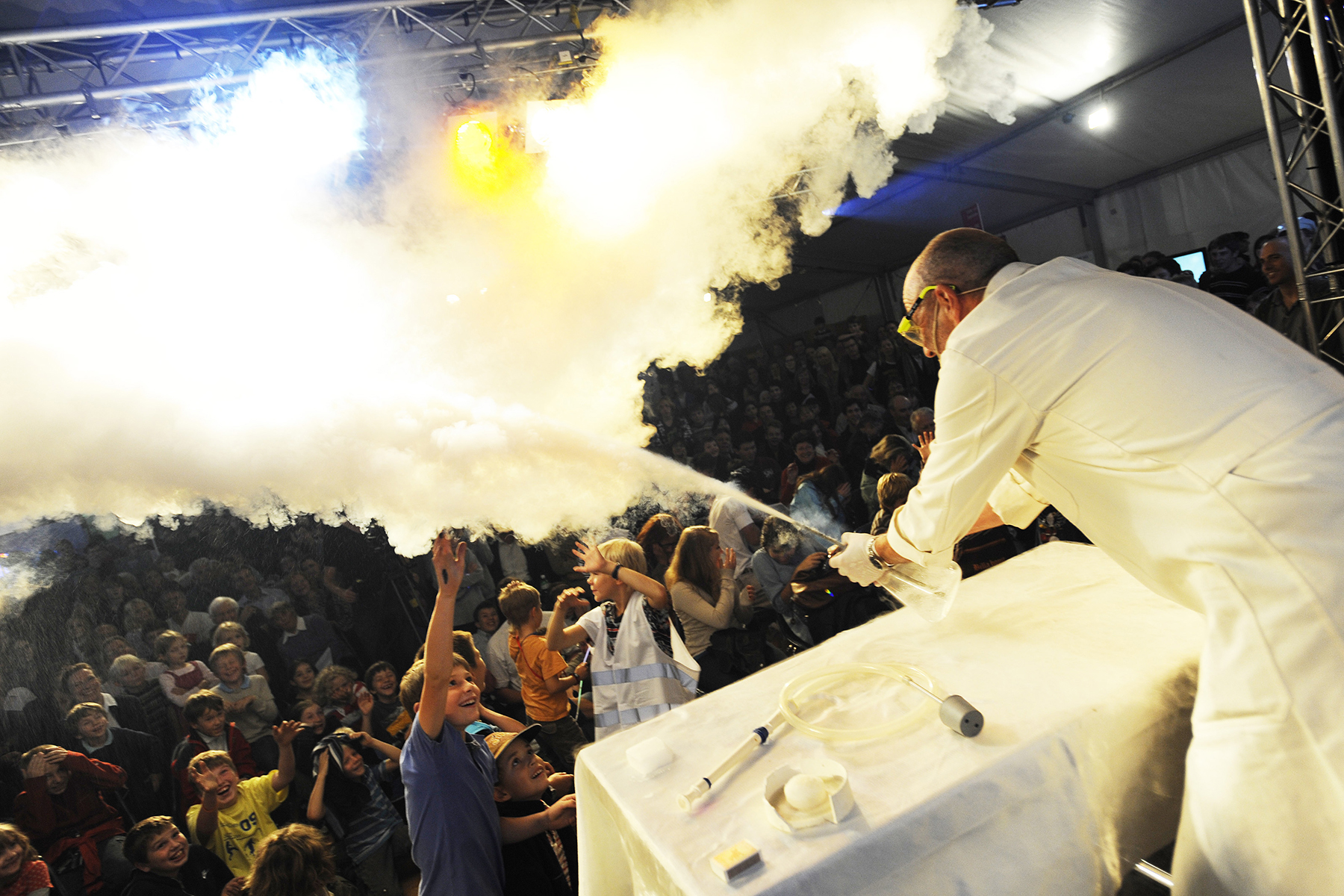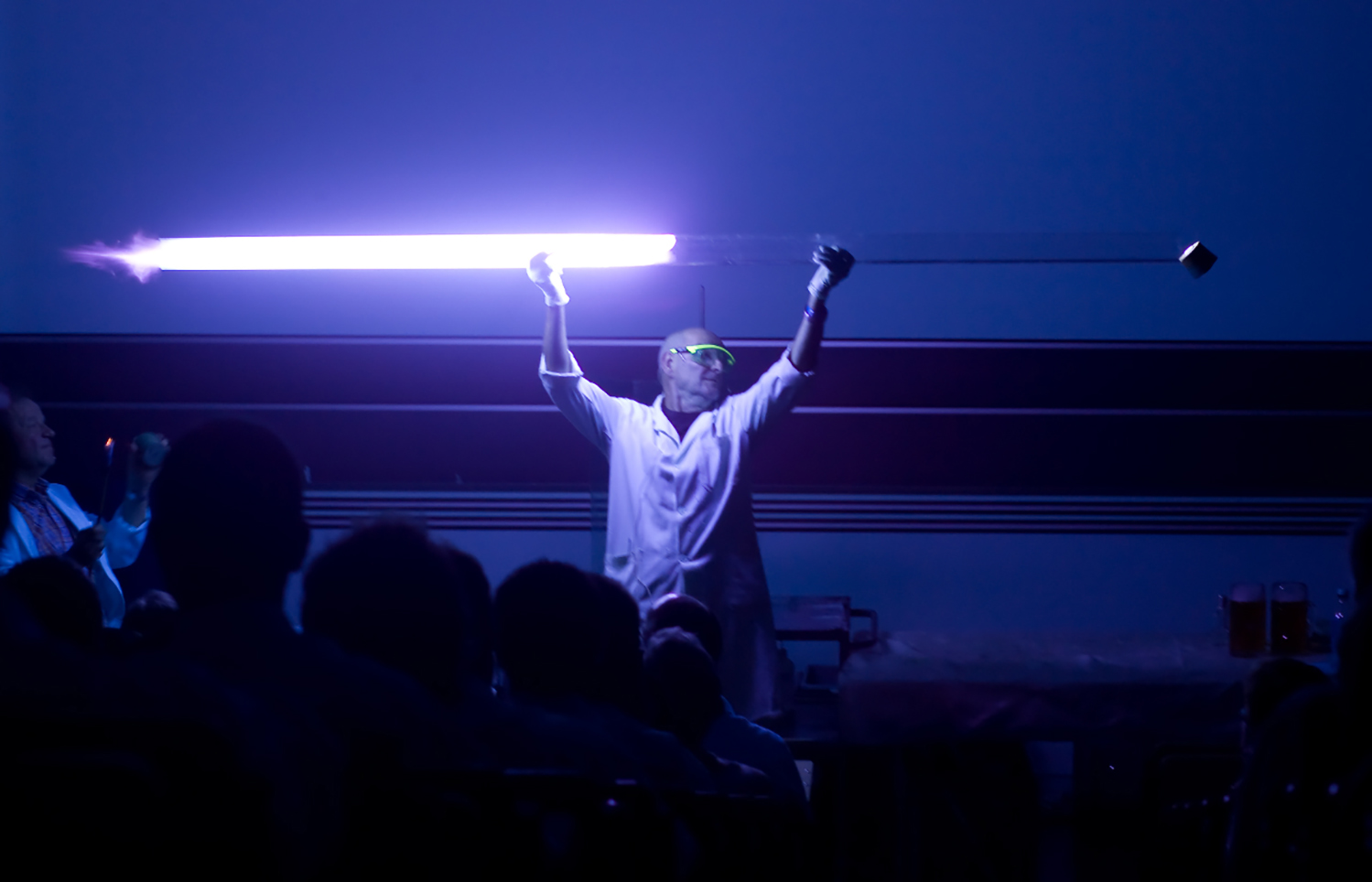"In the end, it was always fun"
For 27 years, Wolfram Uhlig and his assistants have delighted their audience with barking "Chemical Dogs", flash fires of burning oil, and meter-high fountains of beer foam. Uhlig combined entertaining experiments with theoretical background in his shows. Now, he retires.
It is quiet in the TV studio. Suddenly a red heart appears on a dark blue cloth. "Chemistry works wonders! What happened?!", exclaims presenter Kurt Aeschbacher. Wolfram Uhlig and his assistant Bruno Rüttimann smile into the camera. They know the secret and promptly reveal it: an acid-washed cloth plus a diluted sodium hydroxide solution results in a pH change in the dye and hence in a color change. "One could use this trick for T-shirts at a date," jokes Rüttimann. "But unfortunately the dye is carcinogenic," emphasizes Uhlig. The audience in the TV studio is fascinated and laughs – what an impressive experiment.
Wolfram Uhlig knows such excited laughs all too well from teaching but less from the TV studio. Since 1993 he has made a big impression on his audience with his entertaining chemistry shows at various schools, but also in his first semester lectures at ETH Zurich. And yet, Uhlig started out at a purely scientific career: he did his doctorate on organophosphorus and organotin chemistry at the University of Halle in Germany, worked on topics of organosilicon chemistry as a post doc at the Academy of Sciences of the USSR in Irkutsk, and dealt with problems of catalytic polymerization of olefins at the Max Planck Institute for Coal Research in Mülheim an der Ruhr (Germany). In 1991 he qualified as a university lecturer in Halle.
Unattractive chemistry – a case for two
"In the German Democratic Republic, there were twice as many people as you needed at that time – so everyone was trying to get away somehow," Uhlig remembers. At the invitation of Professor Luigi Venanzi, he came to ETH Zurich, and started working for Professor Reinhard Nesper. Nesper was the driving force behind all future projects. "It was the years when ETH was trying to attract students", Uhlig explains, "in the 90s, we had only 30 to 40 students in chemistry. However, that was the case at all universities: chemistry was simply unattractive. Something had to happen."
So public relations at the D-CHAB was established, and the new formed team Uhlig-Rüttimann were supposed to contribute. "At that time, we had set up about 200 experiments. Some of them were even recorded on video. Today, there are many films about chemistry, but this was something new back then", Uhlig states, "so the recording procedure was quite exciting." [hear Audio 1, available only in German]

Over the years, this experimental series led to a chemistry show. As part of ETH unterwegs, Uhlig and Rüttimann presented their show at various schools in Switzerland: "First we had 10 to 15 shows per year, then even 30. ETH transported all our material, which was quite challenging.” Then the whole endeavor became international. But Uhlig and Rüttimann always refused to do their show in English: "At a show you can't think about how you say something, you just have to talk."
Good Chemistry
Rüttimann and Uhlig had been a team for 17 years. The chemistry between them was just right, as presenter Aeschbacher remarked in 2010. This was always the case, regardless whether they made the TV crew sweat with small experimental accidents, whether they forced the crew to do Impromptu live recordings [Audio 2], or whether they kept burning steel wool at Lake Zurich under control [Audio 3]. Rüttimann was a passionate art photographer and courageous scientist, and has been one of the longest-serving laboratory assistants at ETH Zurich at that time – in other words: the perfect partner for such adventurous teaching formats: "He has always been responsible for the aesthetic, and I for the chemistry. You can see from the photos how much heart and soul went into it".

DownloadAudio 2 -Uhlig about experimental faux pas in the TV studio (MP3, 1.3 MB)vertical_align_bottom (available only in German)
DownloadAudio 3 - Uhlig about keeping burning steel wool at Lake Zurich under control (MP3, 1.8 MB)vertical_align_bottom (available in German only)
Rüttimann retired after 47 years – after such a long time that "the computer had not even provided an anniversary service gift for it", Uhlig remarks amusedly. Uhlig continued his show with other assistants (Lukas Sigrist and Kurt Hauenstein) – still committed and successful. "Nevertheless, at ETH Zurich some pushing was always necessary to convince people of the benefits. But with time, even Nobel Prize winner Richard Ernst liked the fact that people's interest was sparked in this way. People remember impressive experiments like the “Barking Dog”, so the ignition of a mixture of nitrous oxide and carbon disulphide according to the instructions of Justus v. Liebig, even decades later."
Feedback as "currency" for success
The "currency" for success in teaching is usually direct feedback. Uhlig has received plenty of positive feedback to this day: "When I recently corrected the 400 exams, some students wrote underneath that it was fantastic how I explained things," he says, not without pride. "The mixture of experiments, scientific facts and historical background knowledge, which I often include, is probably what creates a special connection. It would be nice if even more people would enjoy teaching this way, but also bring talent to the table," Uhlig emphasizes, "especially since there is hardly any pedagogy for lectures." Uhlig has found a great successor in Jan Cvengros. Now, Uhlig looks forward to go hiking in the Alps, and to visit the opera. Nonetheless, he will miss teaching and the shows: "In the end, it was always fun."
This article is a slightly abridged version of an article first published in the CHAB-News of the Department of Chemistry and Applied Biosciences. Read the original article by Julia Ecker here.



